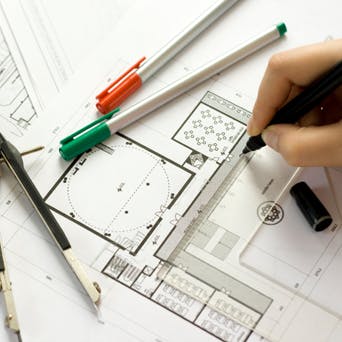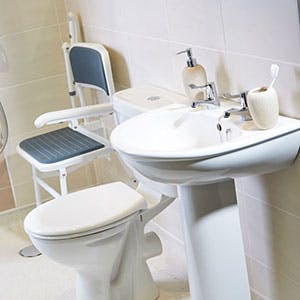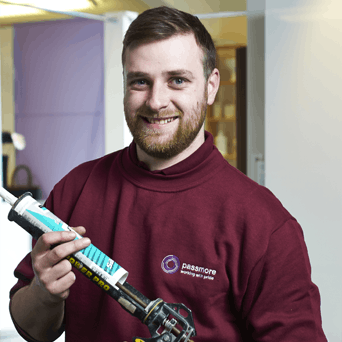An essential guide on replacing a bath with a walk-in shower
Published: 4 June 2024
At one time baths were the most common feature within bathrooms. However, with the varying lifestyles we now lead, there has been a shift and growth in the popularity of showers.
Aside from looking at it from a lifestyle point of view, in general, showers are quicker, easier, and just more convenient especially if you have multiple generations within one household.
If you’re thinking of replacing your existing bath and are thinking along the lines of having a shower instead, then this guide is certainly for you.
.jpg?auto=compress%2Cformat&cs=strip&ixlib=php-1.1.0&s=0434fa80eb1164e9aac9fe35edf76a43)
We have picked out key points that we think individuals and families should consider when they are thinking of making the switch from a bath to a shower.
This includes the numerous benefits of a walk-in shower, potential increased space, and improved accessibility that will meet the needs and requirements of the users.
Some of you may even wonder about the cost and installation process of the shower, which is not to worry as our team of experts has covered all the bases when it comes to replacing a bathtub with a walk-in shower.
Benefits of replacing a bath with a shower
To begin we are going to look at some of the key benefits of replacing a bath with a shower, which we will discuss below.
Reduced risk of falls
Showers are widely considered to prevent falls occurring in the bathroom, This is great, especially for those who have limited mobility as they will be able to have increased confidence in using the shower provided extra accessible bathroom features are provided.
A walk-in shower is a versatile bathing solution as the majority of users can use the area. They’re typically designed with a low, shallow shower entry stepping straight onto a shower tray, making access in and out of the area pretty easy.
That doesn’t mean that it is entirely risk-free of falls, other cautions have to be taken care of, but it is a step in the right direction.

Increased independence
For individuals looking to retain their bathing independence, then some shower installation is certainly the route you want to go down.
This is crucial for those who may be elderly and can choose between different types of easy-access showers. That may include fitting a Corian bench inside of the shower still providing them with a place to sit reducing potential falls and fatigue.
Even better if it is designed to meet the individual's needs and requirements as this will increase their confidence with the installation of accessible bathroom features.
Improved comfort and accessibility
Despite a bath being closely linked to comfort, this can be retained within a shower room, and when it comes to accessing the shower it can accommodate all users compared to the bath.
That is mainly due to its ease of entry into the shower room. Usually, showers have a curb or entry. For example, you have multiple people of various ages living under one roof, so it might make sense to have a shower with a low shower tray or an accessible wet floor that will make the showering safer.
Comfort can be at the top of your list of priorities and if you’re wondering how you’re going establish that within a shower, this could mean putting in a well-fit bench inside the shower with an extra shower head from the side.
This feature will be useful for individuals who have trouble standing up for a long period in the shower, this also helps them to shower without needing assistance.

Enhanced safety for caregivers
If individuals have carers who help them to bathe, then it is more than likely to get messy from time to time, which could also leave them getting wet in the process. But that is if you have a bath.
If individuals were to replace the bath with one of the accessible shower room refurbishments then this could leave both the carer and individual happier as the carer will be able to assist without getting wet.
Above all, showers tend to be quicker than baths and in terms of risk, a shower reduces the chances of injuries for both the caregiver and patient, given the more streamlined and easier bathing solution.
Increased space
Replacing the bath with a shower can be seen as a space-saving tactic. We certainly agree that it does as it creates more space which leaves you with an opportunity to use the space more efficiently.
For those with smaller bathrooms, if it is something that you’re thinking about, it’s worth making the jump for a shower, and we must add that it is a relatively straightforward process when it comes to removing it.
.jpg?auto=compress%2Cformat&cs=strip&ixlib=php-1.1.0&s=f1efc1a89893a9a1d280e3e679836079)
Modern aesthetic
Comparing the two bathing options, showers more so walk-in showers are considered to be associated with a more modern aesthetic than baths.
Walk-in showers are known for their minimalist view, are very simple design, and leave the room with a sense of openness to it
Showers use the same materials such as glass, and stone tiling which complement a modern contemporary design.
As you know the shower creates more space and this allows for the fitting of wall-mounted features.
.jpg?auto=compress%2Cformat&cs=strip&ixlib=php-1.1.0&s=be220d68c7af713a8b6db135dfd3aea5)
Water conservation
Another benefit of a shower which the majority of you will be glad to hear is that the shower uses less water than the bath, but that being said it does depend on how long you use the shower!
Let’s say that if you take a 10-minute shower, you’ll use around 25 gallons of water at 2.5 gallons per minute. In comparison a standard bath might require up to 50 gallons to fill or if you have a freestanding bath, that can take up as much as 70 gallons.
The installation of water-saving showerheads or known to some as a low-flow shower head will work in your favour though, as it can save approximately 6.5 gallons of water per shower. Which in the long run will be a huge benefit to you.
Easier to clean
Easier to clean and maintain, showers offer better ease of maintenance when you’re comparing it to the bath.
As we mentioned earlier in the guide the shower uses materials such as glass and stone tiling, therefore cleaning them is pretty quick and easy, needs just a regular wipe.
Most showers have an easy entry system so this will reduce the awkward maneuvers occurring.
Taking both the materials and how easy it is to maintain, will save you time overall and expended effort into cleaning.
Enhanced comfort
Traditionally the bath was considered and still is as the most comfortable bathing solution. People still love the idea of a long relaxing soak in the bath.
However, showers have recently become more versatile and this is because of the wide range of customisations that you can make to it to enhance relaxation and comfort.
The changes usually consist of a bench giving you a seat option just like a bath, with an extra shower head or two.
Unlike the bath, a shower gives you the option to control the temperature of the shower providing individuals with a better showering experience.
.jpg?auto=compress%2Cformat&cs=strip&ixlib=php-1.1.0&s=d98dd669ba946082379109dabc5574e5)
Increased home value
Whether you go for a bath or a shower it won’t necessarily impact the value of your home.
The usual determining factors such as the location, number of bathrooms and more impact the value of a home.
However, it boils down to the preferences of the individuals and it seems that with more people desiring the more could make your home more attractive to buyers.
Having a shower generally gives you enhanced control over your bathing and is easier to maintain.
Types of showers
At this point, you might have already concluded that you want to replace your shower with a bathroom.
So the next step is what type of shower would be most appropriate and would meet the needs of you and your family.
In the next part of the guide, we will be going through the different shower types that are available.
Walk-in showers
Walk-in showers are one of the most popular shower designs that people will have fitted as part of their bathroom design.
There are different ways to design a walk-in shower to suit all of the users but its core concept remains the same.

A walk-in shower is an open design that doesn’t have a door or an enclosure, providing easy access to the shower.
Another part of its core concept is that you should consider the drainage pipe system of the walk-in shower to ensure that you do not get any leaves and that safety is well-secured.
Shower enclosures with trays
A shower enclosure popular, simple design. The complete shower unit comprises 3 main features: a tray (that drains the water), shower panels and the head.
The brilliance of this design is that you can make a few adjustments to suit your needs and you have the option to decide on the height of your shower tray.
For the surrounding area of the shower, you can either have fit glass or plastic panels, either way, it creates a watertight enclosure around the tray, helping to keep the water within the allocated area.
Shower enclosures are a great option to replace the bath and more so for individuals who require adaptation as they can be customised, and can include accessible bathroom features.

Wet rooms
A complete purpose-built design, wet room showers are a perfect future-proof shower concept.
Wet rooms are recognised as a complete design allowing individuals to shower in comfort, safety and ease.
The entire bathroom floor is waterproof fit with anti-slip vinyl floor and the water slopes gently to the lowest point of the floor. Ultimately, it creates an open showering area.
The concept is popular amongst individuals who require bath adaptations as they promote independence and a comfortable showering experience.

Considerations
Before you go ahead and replace the bathtub with a shower installation, there are a few things that you have to consider before it comes to fruition.
Plumbing
As you’ll be making the switch from a bath to a shower, careful planning needs to take place as plumbing adjustments are going to need to take place, which might include relocating the drain or the water supply.
Other assessments of the bathroom would need to take place to ensure that the shower can be installed.
A bathroom professional, such as ourselves at More Ability or plumbers, can come out to your home to take out an assessment of the bathroom and create a plan that will allow for the shower fitting.
Waterproofing
All bathrooms and showers have to be waterproof, it is an essential factor that cannot be overlooked as it will prevent water damage from occurring in your bathroom.
This is more so important when you have a shower installation, such as a walk-in shower or wet room, to prevent leaks or moisture build-up.
Drainage
The drainage is another element that needs to be hugely considered for the bathroom because having a fully functioning drainage system allows for a hygienic bath system that is also safe, which is even more critical for users who have disabilities.
When you have a fully working drainage system it takes away water build-up that could spiral into other problems within the bathroom that could involve the deterioration of the floor or even other structural areas of the room.
Having a fast working drainage system is important for those who have limited mobility or who use a wheelchair as the water will drain quickly avoiding any puddles and a potential risk of imbalance to the individual.
In general, for hygiene purposes, having a functioning system means there won’t be any stagnant water taking away the potential for bacterial growth.
Accessibility
Accessibility is a key factor in a bathroom and becomes and plays an even bigger role when you’re replacing a bath with a shower.
Provided that safety, manoeuvrability, and how long it will last given it meets all requirements (future-proofed design) will ensure an independent showering experience for all users.
The most appropriate shower would be either the
accessible walk-in or
wet floor shower room. Either one of those designs meets the criteria of accessibility and their stylish design can suit the majority of users and would be perfect for a home that is housing multiple generations.
Installation process
The next stage of the process is understanding the steps of the installation of a new shower.
The process includes the removal of the existing bath in place.
Preparation
Let’s hope at this point before the installation of a new shower, the measurement of the space and the type of shower has been decided on that you’ll be replacing it with.
Removal of existing design
The first step would be to turn off the water supply to the bathtub, and you’d want to drain the rest of the remaining water from the tub itself. Then remove the bath, the taps and pipework.
Installation
This part is where the plumber is important to help with the pipework of the shower. As we mentioned, if the bathing solution is moving to a different location in the bathroom, some pipe adjustments will need to occur.
Afterwards, it is then onto the assembly of a shower which depends on which design you have gone for. Most importantly you’ll have to ensure the shower is properly sealed to prevent leaks.
On the inside of the shower depending on the type of wall covering that you would have decided on, whether it is tiles or wall boarding they would need to be fit at this point to complete the shower installation.
After assembling the shower, you'll be glad to know that it's now about fitting the bathroom with accessible bathroom designs, this will be according to the user's requirements and preferences, which might include fitting anti-slip vinyl flooring, accessible wallboards, grab bars and other accessible features.
Once all of the shower features and fittings have been installed. It is then about testing the shower to make sure that there is proper water flow and drainage.
Cost and timeline
The replacement of a bath with a shower installation cost can vary based on a few key elements that are involved in the process.
The most obvious is the space availability, if the bathroom is large then it is most likely to cost more to renovate than a smaller bathroom.
Other considerations include the design of the shower unit and whether any plumbing adjustments need to be made could add to the overall cost.
Design features such as the tiling, and safety features will add to the overall cost of the new shower room.
Unless you find an organisation like ours that offers a full-project managed service, labour and demolition could be part of the cost of the project.
The cost of replacing a bath with a shower can vary depending on the complexity of the job and the quality of materials you opt for.
A full renovation of a walk-in shower can begin at around £2,000 and go up to as much as £15,000.
How much time the entire project would take can depend on the work involved in the renovation.
For the smaller and simpler jobs, it can take 3-4 days to remove and replace it with a shower. Whereas the bigger bathrooms or those that are more detailed can take up to 2 weeks installation.
How our full design and fit service can help you replace your bath with a shower
Changing the bath for a shower is one of the best decisions that you can make for your home. A shower is a versatile bathing option compared to a bath.
Thanks to the large amount of customisations you can make in the shower it ticks all the boxes when it comes to functionality, you have the option to include accessible and aesthetically pleasing features.
To achieve a fully functioning modern shower room, the design has to be well-thought-out and meet the needs of all the users.
We’re leading experts in bathroom adaptations in Yorkshire and have a team who can help you not only replace a bath with a shower but also design a new shower that helps to make your daily shower life easier.
You can give us a call or book a free design appointment online.
FAQ's
What are some tips for choosing the right shower for my bathroom?
If you’re in the middle of choosing which shower is the best option for your bathroom, there are a few tips we think would help you on your way.
The first step is to create a budget for your shower room. Then it would be to consider yourself and users and there is a need for accessibility for the shower.
We think that you should measure up the shower and then take into consideration the available space and list the types of showers that would fit in the available space and your requirements, don’t forget to include your personal style and preferences.
Can I replace my bath with a shower myself?
The answer is yes you can but there are some skills and experience that are necessary to carry out the shower renovation. Depending on the job, it could involve plumbing, and electrical work which are best to be handled by a professional, so unless you’re qualified to do so we advise that you contact qualified contractors.
Share this Post


.jpg?auto=compress%2Cformat&cs=strip&ixlib=php-1.1.0&s=0434fa80eb1164e9aac9fe35edf76a43)


.jpg?auto=compress%2Cformat&cs=strip&ixlib=php-1.1.0&s=f1efc1a89893a9a1d280e3e679836079)
.jpg?auto=compress%2Cformat&cs=strip&ixlib=php-1.1.0&s=be220d68c7af713a8b6db135dfd3aea5)
.jpg?auto=compress%2Cformat&cs=strip&ixlib=php-1.1.0&s=d98dd669ba946082379109dabc5574e5)





















